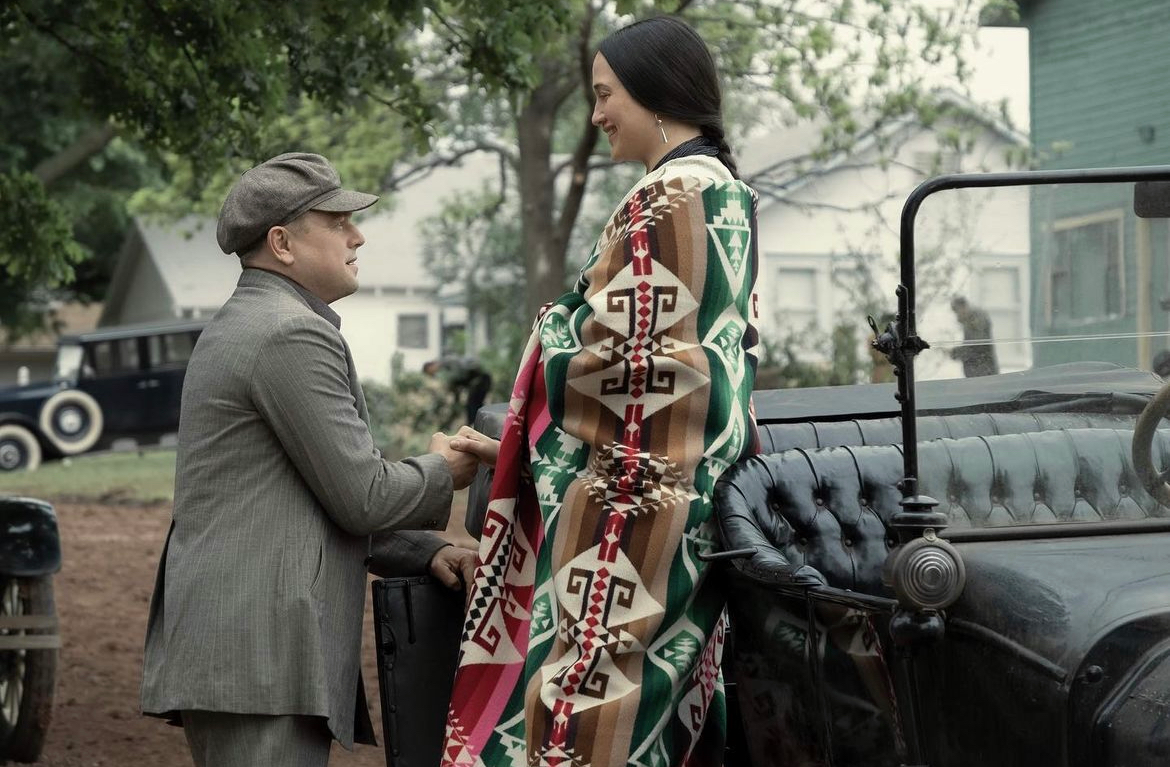At the end of Martin Scorsese’s epic western a radio show producer presents a live play about William ‘King’ Hale’s Reign of Terror over the Native American people in Osage county, Oklahoma announces the fact that despite the murders being the start point of the formation of the FBI, the reality is that it isn’t so much a triumph for American justice. He narrates the fates of the main players and how many of the criminals faced no permanent consequences. Instead, he makes mention of Mollie Burkhart Cole and how she and her people should never be forgotten. Radio plays such as the one Scorsese crafts were broadcast in the 1930s, but they were tales of action and adventure lionising the G-Men who stopped organised crime. The Osage people became footnotes; many unnamed or misnamed. It was a period where “You got a better chance of convicting a guy for kicking a dog than killing an Indian.”
Initially Martin Scorsese was going to adapt David Grann’s journalistic account of the same name into a criminal vs. law enforcement narrative. However, meeting with Native American activists and historians led him to change the focus of Killers of the Flower Moon to one avoid once again the victims of the heinous murders being erased once again. Thus, Scorsese writing in conjunction with Eric Roth foregrounds the voices of those historically dispossessed. Make no mistake, Killers of the Flower Moon remains very much a story that is recognisable as a tale of corruption, gangs, violence, and venal men but Scorsese expands his canvas to honouring the culture and dignity of people murdered for oil and mineral rights.
The film begins in the late 19th century where a chief is burying the pipe of a member of his people. Already after years of frontier wars and genocide and being forcibly removed or displaced from their ancestral homes, the chief warns “We cannot become like them.” The scene shifts from a burial plot to a bubbling in the earth where oil erupts and covers young men in liquid gold. The landscape of the Osage Nation becomes an epicentre of oil production – the Osage people by the 1920s were per capita the richest people in America. Where money flows, greed follows.
Greed is personified by William Hale (Robert De Niro) known as “King of the Osage” a charismatic and deadly ranch owner from Texas who integrated himself into the lives of many prominent Native and white families. He covered his nefarious schemes with the hand of charity and benefaction for the Osage people. Although Hale and his nephews, including Byron Burkhart (Scott Shepherd) and Ernest Burkhart (Leonardo DiCaprio) are the obvious faces of criminal enterprise, Scorsese presents a system that is already corrupt. State appointed “guardians” control the money for Osage people they have deemed “incompetent” – grifters and chancers come to Fairfax in the hopes of becoming “Squaw Husbands” digging in on the newfound wealth of the community and hoping to inherit headrights to their land holdings.
Mollie Kyle (Lily Gladstone) listens patiently as a man handles her accounts and asks her to justify the spending of her mother, Lizzie (Tantoo Cardinal) on maize and medication. Behind her eyes is the fire of an intelligent woman aware that she is being minimised and cheated. Mollie herself is a diabetic and is self-managing her illness while caring for her mother’s increasingly fragile health. She is also aware that she is a target. It seems surprising then that Mollie begins to fall in love with the simple Ernest, who acts as her driver. She calls him a coyote but feels that the former army veteran is looking to settle and will be a good husband. Ernest has been groomed by William to marry Mollie because her family’s headrights. At first it appears that Ernest, slow witted and easily manipulated, is a puppet in his uncle’s schemes. He loves Mollie, he raises a family with her, but he too is driven by greed.
Scorsese follows a three-act structure. He gives the audience an introduction to the period and the key players, he shows us the crimes both extremely violent and subtle and he introduces the Bureau of Investigation (BOI), recently formed by J. Edgar Hoover to look into crimes which crossed jurisdictions, and finally relates a courtroom drama. Within the dizzying spectacle the audience sees poisonings, badly staged suicides, the complete destruction by bomb of Mollie’s sister Rita (Janae Collins) and her husband Bill Smith (Jason Isbell) home killing their entire family. Henry Roan (William Belleau) is murdered by go-betweens for Hale.
By the time we reach Jesse Plemons arriving as BOI agent Tom White with his undercover operatives untangling the vast swathes of murders, including that of Anna Brown (Cara Jade Myers) also one of Mollie’s sisters, we realise how vast the conspiracy was and how Hale had avoided any repercussions for so long. Hale proclaimed, “I love the Osage, they’re beautiful people – but their time is over.” He spoke their language, he ingratiated himself in their ceremonies, he dined in their homes. De Niro is extremely capable in his role as Hale, for decades he has been playing a man of malignant intentions but also mercurial charmers.
Leonardo DiCaprio, another of Scorsese’s frequent collaborators slips into the skin of Ernest Burkhart with ease. Here is a man as pathetic as he is stupid and greedy. Here is a man who is tarred with stained teeth and an ugliness that reaches through his every pore. Here is also a man who loves Mollie but is a moral coward and chooses to believe he’s protecting her while knowing he is killing her and has taken away from her everything she loved.
Lily Gladstone has been a phenomenal actor for years and a staunch activist for Indigenous Americans. Lily has proven her mettle in the films of Kelly Reichardt (Certain Women is a must-see). As Mollie, Gladstone’s performance is beyond simple adjectives. Mollie’s grief, resilience, fear, can be conveyed with a single look. Yet Gladstone gives the audience so much more. In silence she is transfixing, when she speaks, she is devastating.
Once again Thelma Schoonmaker (editor), Rodrigo Prieto (cinematographer), and the recently departed Robbie Robertson (music director) ensure the audience is being given the best Scorsese can offer. The addition of veteran production designer Jack Fisk who has worked with Paul Thomas Anderson, David Lynch, and Terrence Malik adds to the authentic 1920s setting. In terms of craft, it’s difficult to imagine a film more meticulously designed in 2023, even with Barbie and Oppenheimer competing.
Killers of the Flower Moon is one of those films you can say a “cast of thousands” apply to. Not even mentioned in this review by name are such talents as John Lithgow and Brendan Fraser, let alone the essential indigenous actors. Moreover, it is not just the people on screen that are referred to but the people we see in flashes and the many people whose existence has been wiped out. Reports of The Tulsa race massacre flick up on a cinema news reel. The influence of early silent Westerns in condemning Native Americans as “savages” is hinted at. The rugged individualism of the Western hero is symbolised when Mollie gifts Ernest a Stetson and he begins to feel he is “making his way” in a life he deserves. On the streets of Fairfax, a town parade nestles beauty queens with local esteemed resident Pitts Beaty (Gene Jones) in full Ku Klux Klan regalia. Scorsese deconstructs the very seams of American exceptionalism.
Killers of the Flower Moon is a gripping condemnation of America and its myths. What could have been yet another version of mythmaking in the form of a procedural becomes an extended scream about institutionalised injustice, not a reductive crime thriller (although it is a crime thriller). Scorsese creates layer upon layer of incisive studies – not just those of men whose greed is insatiable, the greed that white America has fostered for centuries. Killers of the Flower Moon is designed to get under the skin and reveal the scars and open wounds that American history has wrought.
Director: Martin Scorsese
Cast: Lily Gladstone, Leonardo DiCaprio, Robert De Niro
Writer: Martin Scorsese, Eric Roth, (Based on David Grann’s novel Killers of the Flower Moon)



